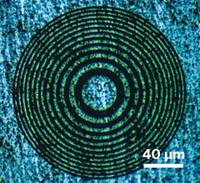Advertisement
Grab your lab coat. Let's get started
Welcome!
Welcome!
Create an account below to get 6 C&EN articles per month, receive newsletters and more - all free.
It seems this is your first time logging in online. Please enter the following information to continue.
As an ACS member you automatically get access to this site. All we need is few more details to create your reading experience.
Not you? Sign in with a different account.
Not you? Sign in with a different account.
ERROR 1
ERROR 1
ERROR 2
ERROR 2
ERROR 2
ERROR 2
ERROR 2
Password and Confirm password must match.
If you have an ACS member number, please enter it here so we can link this account to your membership. (optional)
ERROR 2
ACS values your privacy. By submitting your information, you are gaining access to C&EN and subscribing to our weekly newsletter. We use the information you provide to make your reading experience better, and we will never sell your data to third party members.
Materials
Carbon Nanotubes Light Up Silicon
Photonics: The carbon materials could help researchers produce cheap silicon components for optical computers
by Katharine Sanderson
May 3, 2012

To reach super-fast processing speeds, future computers may run calculations using light instead of electrons. But, currently, materials scientists haven’t found the right materials to move, store, and change light into useful wavelengths for computer applications. Now French researchers have demonstrated that a mix of silicon and carbon nanotubes might meet those needs (ACS Nano, DOI: 10.1021/nn204924n).
Silicon, already widely used in conventional microprocessors, is a promising material for light-based computing because light moves through it quickly. But silicon can’t generate and emit light on its own. To make silicon-based processor components produce light, researchers have tried adding other materials, such as germanium and other semiconductors. Unfortunately, Manufacturing methods used for these materials aren’t compatible with those for silicon. Also, the materials can’t handle the temperature changes that occur inside computer processors.
Researchers at the Institute of Fundamental Electronics, in Paris, turned to carbon nanotubes to enhance silicon’s properties. Carbon nanotubes are good at absorbing and emitting photons, says Nicolas Izard, a member of the research team, and scientists can tune the wavelength of light the materials emit by changing their size.
To test the tubes’ usefulness, the team coated the top of a silicon structure called a waveguide with single-walled carbon nanotubes. Waveguides direct light much like a fiber optic cable does. In an optical microprocessor, waveguides would need to generate light and then transmit it to other waveguides. The researchers’ structure had an open channel running through the silicon that varied between 275 and 450 nm in diameter.
When they shined laser light at a wavelength of 800 nm on the top of the guide, the nanotubes absorbed it and then reemitted light into the waveguide channel. The channel then guided the light out of the structure, demonstrating that the nanotube-coated waveguide was a practical light-generating device. The emitted light was at a wavelength of 1.3 µm, which is similar to light used in telecommunications applications. Also, heating up the device didn’t change its performance: The researchers tested it at 20, 60, and 100º C, and there was no change in the light emitted by the waveguide.
This device is the first example of carbon nanotubes directly integrated into a silicon waveguide, the authors say. The team is now looking to produce a device that generates light from electrical signals instead of a laser, he says.
Liang Feng, of the California Institute of Technology, describes the design as “simple but clever.” He points out that using carbon nanotubes instead of germanium or other semiconductors could significantly lower production costs. He says the next challenge is making the device compatible with integrated circuits already in use in computers.





Join the conversation
Contact the reporter
Submit a Letter to the Editor for publication
Engage with us on Twitter